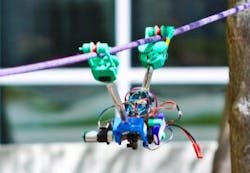Robotic soccer players, snakes, shark-chasers, and even actors?
Fans of the Terminatorfranchise can empathize with me when I say that the amount of robots being introduced into everyday life is just a bit perturbing.
…No, not really, but anyway to fit in a Terminator reference, I suppose. Robots and robotic systems are already finding ways to advance and improve manufacturing, and are working toward other applications like firefighting and first-responder duties.
The latest thing I’ve come across on robots is the SkySweeper, an inexpensive robot that inspects power lines. Developed by engineers at the University of California San Diego, the SkySweeper is made up of off-the-shelf electronics and plastic parts that were printed on an inexpensive 3D printer. Future iterations of the SkySweeper could feature induction coils that would harvest energy from the power lines, enabling it to stay deployed for weeks or months at a time. It could also be fitted with mounted cameras that would provide a vision inspection tool for the crew.
Nick Morozovsky, a grad student in the UC San Diego mechanical engineering program and the designer of the robot, says that current line inspection robots are large, complex, and expensive, but with the SkySweeper, a much simpler and less expensive model will be made available. (The current prototype could be scaled up for less than $1,000.)
Here’s something to think about:
The first PC, according to Columbia University, was the IBM 610 Auto-Point computer. It was keyboard-controlled and designed for use in an office to perform such tasks as matrix arithmetic, the solution of sets of simultaneous equations, stress and vibration analyses, and actuarial computations, among others. It used vacuum tubes, a magnetic drum, and punched paper tape readers and punchers.
The IBM 610 Auto-Point (which represented the computer’s ability to automatically adjust the decimal point in floating-point arithmetic) cost $55,000. In 1957.
The point here is that this SkySweeper robot may very well be capable of performing the tasks of previous models that are significantly more expensive. Today is August 9, 2013, so the IBM 610 Auto-Point hit the market 56 years ago.
Just think where robots will be 56 years from now. Scared yet?






